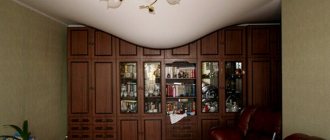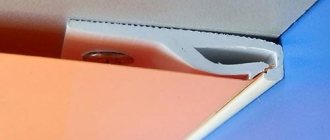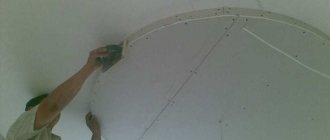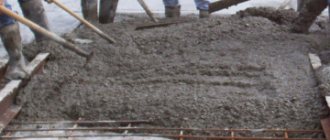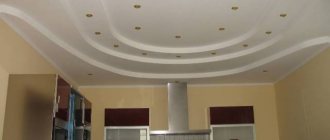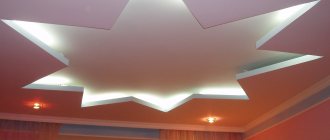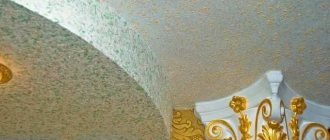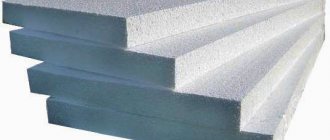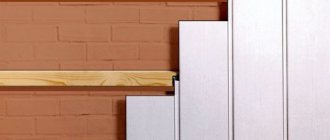Repairing suspended ceilings made of film or fabric is a relative concept. The stretch ceiling contains practically no elements that would be subject to full repair. In most cases, we are talking about small cuts and holes on the surface of the film or fabric. Then such methods as stitching the film and further painting, lifting the ceiling (if the hole is not far from the wall), applying patches or decorative inserts, using holes as openings for additional lamps are suitable.
Holes in the suspended ceiling
If the hole in the ceiling is large or there are several in different places, then the best solution would be to completely replace the tension element. And here you may need the help of a work team so that the new ceiling is stretched efficiently, without violating technology.
In this article we will look at what methods exist for repairing holes in a suspended ceiling. Often, problems with the integrity of the ceiling can be solved independently and with a minimum of effort.
Precautions to maintain the integrity of the stretch ceiling
The appearance of holes in the ceiling is almost always associated with non-compliance with the rules of its operation, with the use of low-quality material or unprofessional installation.
The rules for installing and operating suspended ceilings are given below.
- Use only high-quality materials and use the services of professional construction and installation teams (if you are not sure that you can do everything correctly on your own). Frequent reasons for rupture of seams or deformation of the working surface of the ceiling due to the lag of the profile is precisely unprofessional installation.
- Make sure that children do not throw toys with sharp parts towards the ceiling. Even an ordinary ball can cause, if not rupture of the ceiling surface, then its deformation. The same applies to champagne corks and outdoor games at parties, when guests can jump high and point their hands hard at the ceiling.
- Carefully install the curtain rod or baguette. Often the edges of these elements are sharp enough to tear the tension film. The solution is to use softening pads placed between the cornice (baguette) and the film.
Prices for suspended ceilings
suspended ceiling
Causes of holes in suspended ceilings
The ceiling may require repair and replacement not only if it is cut or torn. There are frequent cases of flooding by neighbors from above, due to which all the water collects on the ceiling in one continuous bag. This happens because the material for the stretch ceiling (polyvinyl chloride) is very elastic and waterproof. Yes, it can save your furniture, but once the water is removed from the ceiling, it will most likely need to be completely replaced, as it will stretch so much. Especially if the water was hot. Fabric stretch ceilings do not stretch, but after flooding, unpleasant stains remain on them.
If you use poor quality fabric, it may sag over time or stick to the concrete ceiling base (pull-in). Typically, these cases are covered under warranty and are subject to free repair (if you ordered installation).
Important! If holes and cuts appear in the suspended ceiling, do not delay eliminating them. Due to constant tension, the edges of the hole can become very large, which will only complicate the repair. If it is impossible to eliminate the defect immediately, then the hole can be temporarily sealed with tape.
All cuts and holes in the suspended ceiling must be repaired immediately
What glue is suitable for stretch ceilings
To repair a stretch ceiling, you need a composition that reliably fixes the canvas and does not damage the PVC film or fabric. Professionals choose the cyanoacrylate product “Cosmofen CA 12”. This is a one-component adhesive that is used for any plastics, rubber, leather and even metals. In the case of suspended ceilings, Cosmofen is used for the following work:
- connection of harpoons;
- repair of vinyl films and polyester fabrics;
- gluing the harpoon to the PVC sheet;
- installation of thermal rings, pipe loops and ventilation grilles.
Advantages of Cosmofen glue:
- sets quickly, as it has high adhesion;
- dries completely in 6 hours (at air humidity of about 60% and temperature +20ºC, in other conditions the time may differ);
- reliably fixes glued surfaces;
- does not harm health, as it is non-toxic;
- resistant to frost, heat and sunlight (used both indoors and outdoors);
- not susceptible to mold or corrosion.
Attention! It is not recommended to use regular super glue and other similar products. An unsuitable composition may not provide a reliable connection of materials and may even damage the fabric.
Darning and sealing holes on a suspended ceiling
Small cut or small hole . This is the easiest repair option that is possible for fabric stretch ceilings. You just need to take a strong thread (nylon) and carefully sew up the hole using a thick needle. The resulting seam can be painted over with paint that best matches the color. If you are lucky and the size of the seam is small and the paint is suitable, then traces of the repair will be almost invisible.
Important! It is best to paint over seams or patches using acrylic paint. Use a soft roller or spray bottle to apply it.
Repairing small cuts
For large holes in fabric ceilings, using a patch will work . The ideal option is to use the same fabric from which the ceiling is made. Often after installation there are leftover material left - it is better not to throw them away and store them for such cases. The patch should be slightly larger than the size of the hole itself in order to cover its edges with a margin. If the patch is a different color, it will be more difficult to make it invisible, but the problem can be solved by choosing the right paint.
To glue the patch, you should use transparent adhesives that, after drying, do not become rigid and do not deform the canvas (such as “Super Glue”). Rubber-based glue or the classic “Moment” are much more suitable. The gluing area should be carefully but gently smoothed out; without this, noticeable wrinkles will appear on the ceiling. You should not press the patch too hard, as this will lead to deformation of the canvas.
Prices for fabric stretch ceiling
fabric stretch ceiling
Important! If a small cut was made on the fabric ceiling, and not a hole, then the damage can be sealed from the inside with tape or adhesive tape. This will hold the edges of the cut together and prevent it from growing in length.
Using applications . A good way to hide a hole is to use reflective or luminous stickers as a patch and at the same time a fresh decorative element. Ready-made stickers can be bought at the store, but if you wish, you can cut them yourself using suitable material (for example, Oracle).
Decorative patches on a stretch ceiling
To prevent a single sticker from looking strange and attracting too much attention, just make a few more stickers in different places. This will create a feeling of a holistic decorative composition.
How to repair a suspended ceiling if it is torn
If damage to the stretch ceiling has been discovered, you cannot do without the help of qualified specialists, but there are times when you can fix the problem yourself at home. For example, if the ceiling is torn and the size of the cut is small, then you can fix it yourself.
The simplest and most popular way is to apply decorative tape to the cut site. If necessary, you can make a patch, but in this case it is worth considering that such a repair will be noticeable to anyone who looks up.
The next method is much more effective, but it is complex. In this case, it is recommended to install an additional lighting fixture or decorative grille.
To fix the problem you will need the following materials:
- seal – is a ring made of plastic, which can be purchased at any hardware store or made independently;
- glue – for these purposes it is recommended to use quick-drying glue, which can also be used for PVC films;
- a knife with a set of blades for cutting cardboard;
- wide transparent tape.
The work is carried out according to the following algorithm:
- The edges of the tear are secured with tape.
- The surface is thoroughly cleaned. Apply glue to the plastic seal.
- The ring is pressed tightly against the canvas and held for about 15-20 seconds.
After this, you can insert any decorative element into the ring and the damaged area will be reliably camouflaged.
Advice! If necessary, instead of a decorative element, you can install a lighting device.
What to do if the stretch ceiling breaks along the seam
As you know, all tension structures are given a warranty period of 10-12 years. If the PVC sheet comes apart along the seam, then this is a reason to contact the company that did the installation for a warranty claim. According to the concluded agreement, the manufacturer undertakes to eliminate the defect that appears or to completely replace the stretch ceiling if it is torn.
Seam rupture occurs in the following situations:
- low quality material was used in the production process;
- the welding of the seam was carried out in violation of technology;
- During installation, the master pulled the PVC film quite tightly.
Repairs when a seam ruptures are carried out extremely rarely; most often, a complete replacement is performed. Many experts do not recommend re-using the services of the company through whose fault the damage occurred. In such situations, it is worth demanding financial compensation and seeking help from professionals.
If necessary, you can watch what to do if the stretch ceiling breaks in the video.
If the suspended ceiling near the chandelier is torn
As practice shows, a cut located in close proximity to a lighting fixture is much more difficult to eliminate and disguise than other types of damage. In most cases, these damages are quite large, as a result of which it is recommended to use special patches or cardboard.
Immediately after detecting damage, it is worth fixing it and preventing further tearing. For these purposes, you can use any tape. The edges of the gap are connected to each other and glued.
When the edges are securely fixed, you can begin to eliminate the defect that has appeared. In this case, it is recommended to seek help from a professional, since it is unlikely that you will be able to fix the problem yourself without the proper knowledge and the availability of construction tools.
After the patch has been installed, it is worth using decorative elements, as it will catch the eye. There are people who choose lighting fixtures with a large diameter, resulting in the patch being completely covered, such as round ceiling chandeliers. If necessary, you can use sticky-based decorations and decorate the surface of the ceiling with beautiful flowers and butterflies.
Advice! It’s worth showing a little imagination to transform the PVC canvas.
What to do if the stretch ceiling breaks near the edge
Stretch ceilings are distinguished by a high level of quality and reliability, the service life of which sometimes exceeds 10 years. Often, when carrying out repair work, you may encounter a significant problem when the stretch ceiling breaks as a result of mechanical damage.
If the damage is located at a distance of up to 15 cm from the wall, then the problem can be fixed quite easily. For these purposes, it is recommended to remove the harpoon, carefully trim the damaged area, then heat the PVC fabric well and re-stretch it. It is important to understand that it is quite rare that anyone can carry out this work on their own, so the best solution is to seek help from a specialist.
Attention! When carrying out installation work, it is recommended to carefully ensure that folds and all kinds of irregularities do not appear on the surface.
Installation of additional lamps and piping
In place of a fresh hole in the ceiling, instead of a patch or appliqué, you can install additional decorative lamps. Other options include installing vents, fire detectors, air conditioning units and other useful or decorative elements.
To install such elements, you should use a plastic ring that is attached around the hole. A regular round hole is cut along its inner diameter. This will prevent the hole or puncture from spreading further. You can make the ring yourself using plastic a couple of millimeters thick, or buy a ready-made one at a hardware store (in the accessories department).
Installation of an additional lamp
Instructions for installing the lamp in place of the hole are as follows.
Step 1. On the original ceiling, which is hidden by a suspended ceiling, install platforms of the required height and install wiring for the lamp.
Step 2. Stretch the working PVC fabric.
Step 3. Find the platforms for the lamp by touch and make a mark where you need to cut a hole.
Step 4. Glue a plastic ring in place of the marker.
Step 5. Using a utility knife, cut a hole in the inner diameter of the ring.
Step 6: Pull the wires out of the hole and then install the lamp.
A similar technology is used to bypass heating pipes, which has to be done in almost any room. To bypass, a plastic ring is made equal to the diameter of the pipe plus another 5 - 7 millimeters.
Step 1. The ceiling canvas is tucked into a baguette throughout the room. A distance of approximately 20 centimeters is left next to the pipe on both sides.
Prices for recessed lamps
recessed lamp
Step 2. The canvas is cut from the edge to the pipe.
Step 3. A plastic ring (cut in one place) is threaded into the pipe and glued to the canvas at the cut site.
Bypassing pipes in a suspended ceiling
Repairing a PVC ceiling if the hole is close to the edge of the ceiling
If the hole in the polyvinyl chloride (PVC) ceiling is located close to the wall (no more than 15-20 centimeters), then it makes sense to tighten and “tuck” the canvas into the baguette. A baguette is a static profile on the walls onto which the ceiling is stretched.
Step 1. Fix the edges of the cut or hole with tape to prevent further spreading.
“First aid” for damaged stretch ceilings
Step 2. If a plinth is used in the ceiling system, then it should be removed from the baguette, for example, with a spatula with blunt edges.
Step 3. Extracting the edge of the ceiling from the side of the hole. The extraction technology differs depending on the mounting method. The most popular of them is the method of fastening the canvas using wedges driven into the baguette. After the plinth is removed, removing the wedges will not be difficult - you just need to pry them up a little and pull them down.
Step 4. The edge of the canvas is cut off so that the hole is completely removed, i.e. it is completely cut out.
Step 5. The edge of the canvas is heated with hot air (a regular hairdryer will do) and pulled towards the profile until it can be re-fixed with a wedge or other method.
Step 6. The canvas is inserted into the baguette, and then the plinth is installed.
The canvas is inserted into a baguette
Step 7. A hairdryer is used again to smooth out possible wrinkles. The surface is heated until the wrinkles disappear.
If you ordered the installation of a suspended ceiling from a specialized organization, then any independent repair will void the warranty. In this case, all the consequences of poor-quality installation or the use of poor materials in the future will fall on you - you will have to replace the ceiling at your own expense. Therefore, with a guarantee, the most that should be done is to cover the hole with tape and call a company employee to your home.
How to drain water from a suspended ceiling?
Detailed instructions for draining water from a suspended ceiling are here. It will also be interesting to learn how to repair a stretch ceiling after a cut.
What to do if a suspended ceiling is pierced
Every person should know what to do if they pierce a suspended ceiling. All existing mechanical damage can be divided into several categories, depending on the size:
- small – up to 0.5 cm;
- medium - from 0.5 cm to 6 cm;
- large – from 6 cm.
As a rule, cuts and damage can occur absolutely anywhere, as a result of which the following categories can be distinguished:
- close to the wall - up to 0.5 cm;
- far from the wall - from 0.5 cm;
- in the center of the room.
As practice shows, holes whose size does not exceed 0.5 cm are practically invisible after repair work. To eliminate the defect, use a small piece of PVC cloth of a similar shade. If you are not aware of the damage, the puncture site will be impossible to find after repair.
Cuts over 2 cm are much more difficult to eliminate. Even if you seal the cut from the inside of the ceiling, the mark will still be noticeable. If the damage occurs near the wall, it is recommended to remove the harpoon and cut the canvas to the shape of an arc. After this, the canvas is heated, stretched and tucked into a baguette.
Stretch ceiling rupture along the seam
Ceiling rupture at the seam is a common occurrence for PVC ceilings. Owners of fabric-based suspended ceilings are not familiar with this problem. The main reasons for seam rupture are incorrect, unprofessional installation and the use of low-quality materials.
In the vast majority of cases, ceiling installation companies provide a guarantee against such defects. Therefore, the maximum that will have to be sacrificed is the personal time required for the master to replace the ceiling sheet.
Prices for stretch ceiling “Starry Sky”
stretch ceiling “Starry sky”
Tearing of the stretch ceiling fabric along the seam
It is not possible to repair a ceiling rupture along a seam on your own. Even an experienced specialist cannot cope with this. Therefore, a complete replacement of the canvas will be required. But this also has a number of advantages.
- Even if replacing the fabric due to a tear along the seam is not included in the warranty or it has already expired, a complete replacement will cost much less than installing the ceiling from scratch. You will only need to replace the working surface of the ceiling, while the entire profile will already be in place.
- Replacing the canvas will be quick, since the room has already undergone preliminary preparation during the initial installation.
- A chance to replace the old ceiling with a new and fresh one (including a different color and texture to update the overall design).
Methods for eliminating defects if the ceiling is torn
The stretch ceiling is torn, what should I do? The need to solve such a problem may arise for every owner of a property. In some cases, you have to contact specialists, but often the damage can be repaired on your own. For example, a minor cut appeared on the surface in a place where there should not be one.
Methods for eliminating a defect on a tension surface:
- The simplest method is to use a decorative sticker that is glued to the damaged area of the canvas. You can also take a small piece of material and make something like a patch. It is possible that the result will not be perfect - the ceiling will not look aesthetically pleasing.
- The second option is more complicated. It involves installing an imitation lamp, decorative grille or other element.
For the second method you will need:
- Seal. It is a plastic ring, also called a tread ring. The part can be purchased or cut from a plastic plate 2 millimeters thick.
- Fast drying glue. Cosmofen is often used; it is well suited for PVC film.
- Wide tape.
- Cardboard knife with stackable blade.
Repairs are carried out in a certain sequence:
- The edges of the tear are secured with tape.
- The working surface is cleaned of dust.
- The sealant is covered with glue and pressed against the material, holding for about 15 seconds so that it sets.
- Carefully cut a hole equal to the perimeter of the ring where the decorative element will be inserted.
If the stretch ceiling near the chandelier breaks, what should you do? There are several reasons why this could happen. The lighting fixture may have been incorrectly selected or installed. This defect also occurs if errors are made during the operation of the chandelier. It is better if it has a rounded shape, since the adjacent edges of a square lamp can damage the canvas.
When the stretch ceiling breaks near the chandelier, then additional materials and products will be required. It will not be possible to carefully seal it with PVC material. You can decorate a cut or puncture with a polyurethane plate or a piece of mirror.
Sometimes it happens that damage occurs near the baguette. Then the canvas is removed, cut along its entire length and installed in place.
Tips for repairing suspended ceilings
- Any repair of suspended ceilings should be done with great care, since the material (be it polyvinyl chloride or fabric) is very finicky, and the slightest mistakes will be immediately visible on it. When making repairs, you should be calm and concentrated as much as possible.
- It is best to carry out repairs in the company of an assistant.
- If among your friends there is a person who has already repaired or installed suspended ceilings, then be sure to invite him and pay for the work. Repair by an experienced person will be the best solution.
- For repairs, use only proven and good materials - strong synthetic darning threads, transparent rubber-based glue, high-quality and beautiful stickers.
- Before repairing, it is worth watching several videos, of which there are many on the Internet.
Rubber glue
Remember that it is not possible to repair suspended ceilings in all cases. Sometimes it makes no sense at all.
Table. Situations in which repairing a suspended ceiling is impractical.
| Damage | Short description |
| Seam tear | This defect can be eliminated only by completely replacing the canvas. Moreover, this is not your fault, but the manufacturer or installation team. |
| Ceiling bay | If the PVC ceiling, after being flooded, can still serve as neighbors for some time (provided that it has not stretched too much), then the fabric will require complete replacement. This is due to the fact that noticeable, unattractive stains will remain on it. |
| Big holes | Repair is difficult when the hole is large (more than 20 - 30 cm). Although in this case large stickers or appliqués may work if you first secure the hole well with tape. |
| Ceiling operation for more than 10 years | In this case, it is impractical to repair it; it is worth completely renewing the canvas. |
In what cases is a torn stretch ceiling impossible to repair?
There are situations when the suspended ceiling of a house is pierced, and it can no longer be repaired. This case includes the moment when the fabric parted along the weld seam. In most cases, such canvases must be completely replaced, but if the tear is small, then it is possible to repair it, however, it cannot be done without the help of professionals.
There is another significant defect, which is unlikely to be eliminated using improvised means - the harpoon was torn off. This problem is encountered when the PVC film is under high tension and due to manufacturing defects. In such situations, specialists replace the harpoon.
Many note that such structures are not afraid of flooding, since they can withstand large volumes of water. In reality this is true, but it is important to understand that after prolonged contact with water, yellow stains appear on the PVC fabric, which are quite difficult to remove.
In addition, experts note that a suspended ceiling must be immediately replaced in cases where the size of the damage exceeds 25-30 cm. In such situations, even professional craftsmen are powerless.
Dismantling the ceiling and the cost of its repair by specialists
If a suspended ceiling requires removal for replacement or repair, then the dismantling procedure will greatly depend on the method of its fastening: cam, harpoon or wedge. For any type of fastening, the baseboard or other element of decorative fastening is first removed. The fastenings are loosened as much as possible so that the canvas itself slides out of the profile, but does not tear or stretch.
- The harpoon mounting option allows you to remove and reinstall the canvas. The latter will not change its properties and will not be deformed. This type of fastening uses harpoons that are attached around the perimeter of the entire canvas. Then they are rigidly fixed to the profile. The harpoon type of fastening makes it easy to install and remove vinyl or fabric.
- The harpoonless type of fastening (wedge, cam) involves tightly pressing the blade to the metal profile. This always leads to stretching and deformation of the material. Therefore, when removing the ceiling and subsequent installation, you will need to use a wide plinth that will hide the deformations of the edges.
Methods of fastening a stretch ceiling
